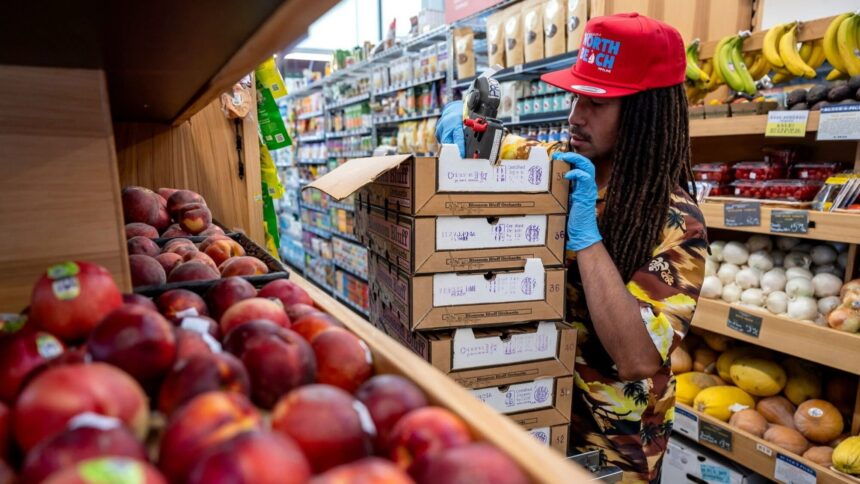I walked along a once-fertile field in British Columbia’s Fraser Valley, the soil now cracked beneath my boots. Michael Chen, a third-generation farmer, pointed to withered rows of vegetables that should have been lush in the June heat.
“Three heatwaves in May alone,” he said, kneeling to examine a stunted cabbage. “My grandfather never saw anything like this. Now it’s every season.”
The scene at Chen’s farm illustrates a growing crisis playing out across global food systems. From British Columbia to Bangladesh, climate change is transforming agriculture in ways that directly impact what we pay at checkout counters worldwide.
Food prices have risen approximately 30% globally since 2020, according to the UN Food and Agriculture Organization. While the COVID-19 pandemic and Russia’s invasion of Ukraine initially drove this surge, climate change has emerged as a persistent force keeping prices elevated—and pushing them higher.
“We’re witnessing what economists call a ‘structural shift’ in food production costs,” explained Dr. Amina Jamal, agricultural economist at the University of British Columbia. “Extreme weather is no longer exceptional—it’s becoming a permanent feature of farming economics.”
The data tells a concerning story. Insurance claims from Canadian farmers for weather-related crop losses have doubled since 2015, according to Agriculture and Agri-Food Canada. Similar patterns are emerging globally, with the World Meteorological Organization reporting that climate-related agricultural losses topped $350 billion in the past five years.
These mounting losses eventually reach our grocery bills through complex but inexorable pathways.
Back in the Fraser Valley, I joined Chen as he calculated his irrigation costs for the month. “Water usage is up 40% over last year,” he noted, scrolling through utility bills on his tablet. “That’s money I’ve got to make back somehow.”
For consumers, the impact varies significantly by food type. Fresh produce shows the most volatility, with prices for climate-sensitive crops like coffee, cocoa, and citrus rising at twice the rate of overall food inflation in Canada.
“Luxury items get headlines when coffee hits $25 a pound, but the real crisis is in staple foods,” said Marianne Takalo, food security coordinator with the Vancouver Food Network. “When rice, wheat, and vegetable prices climb, that’s when we see families cutting meals or switching to less nutritious options.”
The mechanisms connecting climate to food prices are numerous and interconnected. Drought reduces yields, requiring farmers to irrigate more extensively—if they can access water at all. Unpredictable rainfall patterns mean crops fail more frequently. New pest pressures emerge as warming temperatures allow insects and plant diseases to expand their ranges.
These impacts cascade through the food system. The International Panel on Climate Change estimates that for each 1°C of warming, agricultural yields decline by approximately 5% globally. Canada’s climate is warming at roughly twice the global average rate, according to Environment and Climate Change Canada.
But the story isn’t uniform. When I traveled to northern Manitoba last month, some farmers described longer growing seasons that allow new crop varieties. “We’re growing sweet corn now,” said Lydia Monias, a farmer near Thompson. “Twenty years ago, that would have been impossible.”
This highlights a crucial aspect of climate change’s impact on food systems: vulnerability and adaptability vary dramatically by region, wealth, and infrastructure. While some areas gain growing days, others lose their agricultural viability entirely.
Indigenous communities offer valuable perspectives on adapting food systems to changing conditions. In northern British Columbia, I visited the Gitxsan Nation’s food sovereignty project, where traditional food knowledge is being combined with climate adaptation strategies.
“Our ancestors moved their growing and harvesting with the seasons,” explained Elder Sarah Wilson. “They understood change was constant. We’re applying that wisdom with new technologies to build resilient food systems.”
Technological solutions are emerging to address climate-driven food challenges. Precision agriculture using satellite data helps farmers target resources efficiently. Drought-resistant crop varieties offer promise, though access remains uneven globally. Vertical farming and controlled environment agriculture reduce exposure to weather extremes but carry high energy costs.
“Technology alone won’t solve this,” cautioned Dr. Jamal. “We need policy frameworks that help farmers transition to climate-resilient practices while ensuring food remains affordable.”
Policy responses vary widely internationally. The European Union’s Farm to Fork Strategy explicitly addresses climate adaptation in agriculture. Canada’s agricultural policy framework includes climate resilience funding, though critics argue it remains insufficient given the scale of the challenge.
Meanwhile, consumer behavior is shifting in response to price pressures. Food waste reduction has gained momentum as households seek to stretch food budgets. Plant-based diets, often more affordable and less climate-intensive, have grown in popularity, though cultural and personal preferences remain important factors in food choices.
“We’re seeing families getting creative with their cooking,” Takalo noted. “Using more legumes, cooking from scratch, learning preservation techniques. It’s reminiscent of how previous generations handled food insecurity.”
As I finished my conversation with Chen, watching the sunset over his struggling fields, he offered a perspective that balanced concern with determination.
“Farming has always been about adapting,” he said. “My grandparents adapted when they immigrated here. My parents adapted to new technologies. Now we’re adapting to a changing climate. The difference is how fast it’s happening.”
What remains clear is that our food systems stand at a crossroads. The choices made by policymakers, producers and consumers in the coming years will determine whether climate change leads to persistent food inflation or whether innovation and adaptation can create more resilient, equitable food systems capable of feeding a warming world.






